The Impacts of Genetic Modification On Humans, Plants, Animals and Microorganisms
Aleena Shariff
Grade 7
Presentation
Problem
My research study indicates how genetic modification affects our environment (plants, animals and micro-organisms). The objective of my project is to investigate if genetic modification is good or bad for the environment.
My question:
How does genetic modification affect humans, plants, animals, and the environment?
Method
Firstly, in late December I finalized my topic. In January I completed a large amount of background research and research. During January I researched what genetic modification is, genetic modification in plants, the pros and cons of genetic modification in plants, and the pros and cons of genetic modification in animals. In early February I finished all of my research: the pros and cons of genetic modification in humans, the long-term effects of genetic modification, the overall impacts of genetic modification, and how humans can reduce the negative effects of genetic modification. In mid-February, I started working on my Google slides to put on my tri-fold. Then in late February to early March, I inputed my research as well as my data onto the CYSF platform. Then, I wrote my conclusion, finished my acknowledgements, made my tri-fold and wrote my script for my presentation. Once I finished that I recorded my presentation and added it to the CYSF platform. Throughout my whole project, I continuously added my citations.
Research
Thesis
Genetic modification is a method to change the characteristics of an animal, plant, microorganism or human. Scientists transfer DNA from one organism to another when genetically modifying an organism.[1] Genetic modification is also known as genetic engineering.[10] This process is accomplished through targeted removal of desired genes from one being to another.[1] In plants, there are two types of genetic modification. One type is known as cisgenesis which is the transfer of genetic material gathered from a related plant. The other type of genetic modification in plants is known as transgenesis which is the transfer of genetic material gathered from a non-related species.[1] Based on my background research I have concluded that genetic modification/genetic engineering is the process in which scientists modify the characteristics of an organism.
Scientific Principle
Genetic engineering also known as genetic modification is the alteration of an organism's genotype. This is done using recombinant DNA technology to modify an organism's DNA and achieve its desirable traits.[10] Genetic modification is a technique used to modify the characteristics of a human, plant, animal or microorganism. It is when a piece of DNA is transferred from one organism to another. Genetic modification is done through the targeted removal of desired genes from one organism to another.[1]
Genetic Modification In Plants
There are two types of genetic modification in plants: cisgenesis and transgenesis. Cisgenesis is the transfer of genetic material taken from a related plant.[1] An example of this type of genetic modification in plants is cross-fertilizing heterozygous plants that propagate vegetatively.[2] These plants would be potatoes, apples, bananas, etc. Transgenesis is the transfer of genetic material taken from non-related species.[1] An example is when food crops are genetically modified for pest and herbicide resistance.[3]
| Cisgenesis | Transgenesis | |
| Description |
The transfer of genetic material obtained from a related plant. |
The transfer of genetic material obtained from a non-related species. |
| Example | When cross-fertilizing heterozygous plants which propagate vegetatively. (ie. potatoes, apples, bananas) | When food crops are genetically modified for pest and herbicide resistance. |
Pros and Cons of Genetic Modification in Plants
There are many advantages and disadvantages of genetic modification (GM) in plants.
The advantages of genetic modification in plants are smaller uses of pesticides and disease and drought-resistant plants which require fewer environmental resources like water, fertilizer, etc. Some more advantages of genetic modification in plants are that they grow faster, there is more nutritious and tastier food, an increased supply of food with reduced cost and longer shelf life, food with more desirable traits (eg. potatoes produce less of a cancer-causing substance when fried), and medicinal food that could be used as vaccines or other medicines.[4] The disadvantages of genetic modification on plants is it can affect biodiversity (ex. existing species can be taken over by more dominant species).[5] This can also have an impact on non-target organisms and soil and water ecosystems another disadvantage is weeds that can not be killed by herbicides because of GM herbicide-tolerant crops (Superweeds) and some insects have resistance to toxins in GM insect-resistant crops (Superpests). Some more disadvantages are gene flow from GM crops is a threat to weedy and wild crop relatives, non-GM crops and food and organic farming, and genetic modification can cause contamination (serious ecological, economic and soil impacts) which poses a threat to organic certification and the future of organic food and farming. Lastly, genetic modification can cause an increase in herbicide use. Data has shown that from 1994-2020 herbicide sales in Canada have increased by 234% since GM crops (herbicide-tolerant crops) have been introduced.[6]
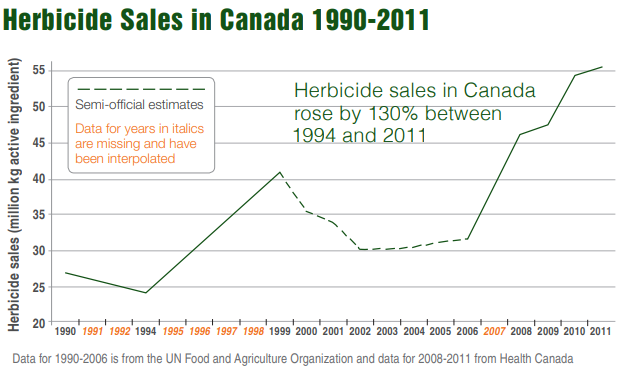
(See citation 7)
| Pros | Cons |
| Smaller use of pesticides |
Affect Biodiversity (eg. existing species can be taken over by more dominant species) Negative impacts on non-target organisms and on soil and water ecosystems |
| Disease and drought-resistant plants which require fewer environmental resources (ie. water, fertilizer, etc) |
Increased herbicide use From 1994-2020 herbicide sales in Canada have increased by 234% since GM crops (herbicide-tolerant crops0 have been introduced |
| Faster growing plants | Weeds that can not be killed by herbicides because of the use of GM herbicide-tolerant crops (Superweeds) |
| More nutritious, tastier food | Some insects have resistance to toxins in GM insect-resistant crops (Superpests) |
| Increased supply of food, reduced cost and longer shelf life |
Contamination (serious ecological, economic social impacts) GM contamination poses a threat to organic certification and the future of organic food and farming |
| Food with more desirable traits (ex. potatoes produce less of a cancer-causing substance when fried) | Gene flow from GM crops is a threat to weedy and wild crop relatives, non-GM crops and foods and organic farming |
| Medicinal foods that could be used as vaccines or other medicines |
Pros and Cons of Genetic Modification in Animals
Genetic modification can have positive and negative effects on animals.
The positive effects are that animals are better able to resist disease, they can grow faster, and reproduce more efficiently than the current species of animals.[8] The negative effects of genetic modification on animals are the alteration of an animal's normal genetic homeostasis and susceptibility to stress. Other negative effects of genetic modification in animals are reduced fertility and lameness*.[11]
*Lameness: the state of being unable to walk because of leg or foot pain.[12]
|
Pros |
Cons |
|
Better able to resist disease |
Alteration of an animal's normal genetic homeostasis |
|
Can grow faster |
Lameness (the state of being unable to walk because of leg or foot pain) |
|
More efficiently reproduce than current species of animals |
Susceptibility to stress |
|
Reduces fertility |
Pros and Cons of Genetic Modification in Microorganisms
There are many merits for genetic modification in microorganisms.
The merits of genetic modification in microorganisms are medicinal benefits to the world's growing population (ex. vaccines). Microorganisms produce enzymes extracellularly which simplifies the extraction method during the purification to produce food enzymes, and specific microbial strains can be selected to collect well-characterized enzymes with specific properties to produce food enzymes (FE). Some more merits of genetic modification in microorganisms is the reduced production cost to produce FE due to shorter production times which requires smaller production facilities. Higher yields can be collected, and the enzymes have higher activity and pH stability (e.g. enzymes collected from thermophilic microorganisms can function at a higher temperature, and they can easily be genetically modified to obtain optimized enzyme products without the production of unwanted metabolites). Genetic modification can also allow for the expression of enzymes in organisms that would not normally produce a particular enzyme.[54]
|
Pros |
|
|
Medical benefits to the world’s growing population |
|
|
Microorganisms produce enzymes extracellularly (simplifies the extraction method during the purification to produce food enzymes) |
|
|
Specific MB strains can be selected to collect well-characterized enzymes with specific properties to produce food enzymes (FE) |
|
|
Reduced production cost to produce FE because of shorter production times which means smaller production facilities are needed |
|
|
Higher yields can be collected |
|
|
Higher activity and stability (e.g. enzymes collected from thermophilic microorganisms will have a higher temperature tolerance) |
|
|
Can easily be genetically modified to obtain optimized enzyme products, higher yields, and better characteristics |
|
|
The ease of introducing genetic modifications in the production of microorganism strains to improve industrial enzyme production |
|
|
Production of food enzymes allows the production yield to increase which improves the characteristics of the produce enzyme and limits the production of unwanted metabolites. It also expresses enzymes in organisms that would not normally produce this enzyme. |
|
|
Recombinant enzymes are used to improve an enzyme's characteristics (activity, temperature optimum, and pH stability) |
Pros and Cons of Genetic Modification in Humans
Genetic modification can have many benefits and drawbacks to humans.
The future benefits of genetic modification to humans are it can be used to prevent, treat or cure certain inherited disorders. These include Cystic fibrosis, Alpha-1 antitrypsin deficiency, Hemophilia, Beta thalassemia and Sickle cell disease. It also may be used to treat cancer or infections, such as HIV.[28,29] The disadvantages of genetic modification to humans (potential risks) are organ and tissue damage if an injection is involved, can cause allergic reactions and certain types of cancers.[30] Other disadvantages of genetic modification to humans are the possibility of targeting the wrong cells, the possibility of infection caused by disease and the possibility of inducing a tumor. Lastly, humans can go through an unwanted immune system reaction (which may cause inflammation, and in severe cases organ failure).[32]
| Pros (In the future) | Cons (Potential risks) |
| Prevent, treat or cure certain inherited disorders… | Damage to organs or tissues if an injection is involved |
| Cystic fibrosis | Allergic reactions |
| Alpha-1 antitrypsin deficiency | Certain types of cancers |
| Hemophilia | Targeting the wrong cells (cells may be damaged causing other illnesses or diseases like cancer) |
| Beta thalassemia | Infection caused by disease |
| Sickle cell disease | Possibility of causing a tumor |
| May be used to treat cancer or infections, including HIV | Unwanted immune system reaction (may cause inflammation, and in severe cases organ failure) |
Long-Term Effects of Genetic Modification
Genetically modified organisms (GMOs) can contribute to the development of cancer by raising levels of potentially carcinogenic substances in the body, an increase in allergies, an increase in antibiotic resistance and problems with the endocrine system. Some more long-term effects that come with genetic modification are reproductive system disorders (congenital birth defects), increased aging symptoms, cancerous tumor growth, autism prevalence, inflammatory bowel disease, intestinal infection, acute renal failure and hepatitis C. Other effects include ADHD, anxiety, schizophrenia, liver and intrahepatic bile duct cancer, kidney and renal pelvis cancer, urinary/bladder cancer, thyroid cancer, acute myeloid leukemia, diabetes and strokes. Additionally, some more long-term effects of genetic modification are senile dementia, Alzheimer's, Parkinson's disease, obesity, hypertension, anemia, dementia, insomnia and vitamin D deficiency. An advantage is that GMOs support climate change mitigation as illustrated below.[17]

The potential avoided greenhouse gas emissions resulting from the yield increases of genetically modified crops (in the European Union). Graph (A) estimates per hectare and year and Graph (B) estimates for total European Union crop area per year.
COCs: carbon opportunity costs of land use.
PEMs: production emmisions
[See citation 16]
What Is Glyphosate?
Glyphosate is a herbicide that is most widely used in Canada today. This herbicide plays an important role in agriculture and non-agricultural land management. It is used to control weeds including invasive weed species. Glyphosate can also be used to control toxic plants like poison ivy.[58]
The graphs below further illustrate the long-term effects of genetic modification. They display a similar trend of an increase in various medical conditions.
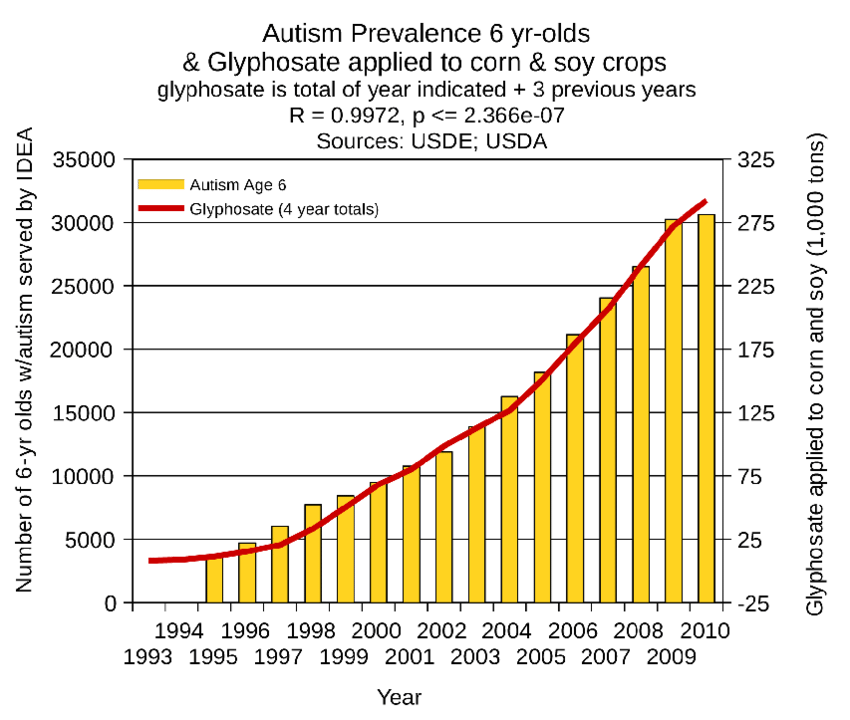
 [See citation 18]
[See citation 18]

 [See citation 19]
[See citation 19]
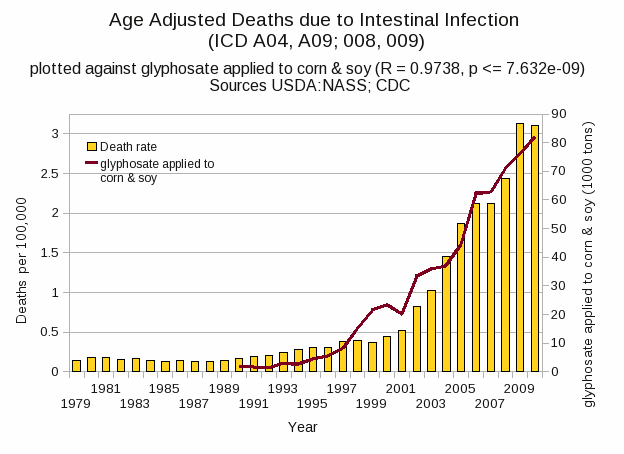
[See citation 20]
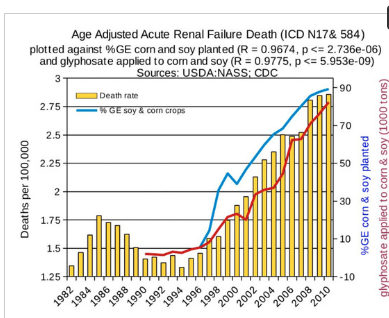
 [See citation 21]
[See citation 21]
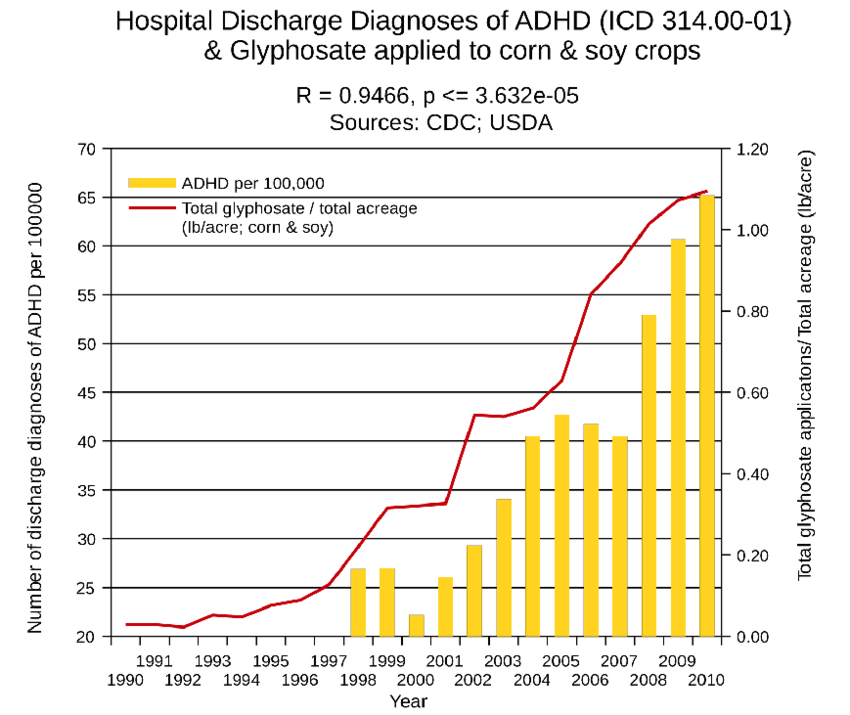
 [See citation 22]
[See citation 22]
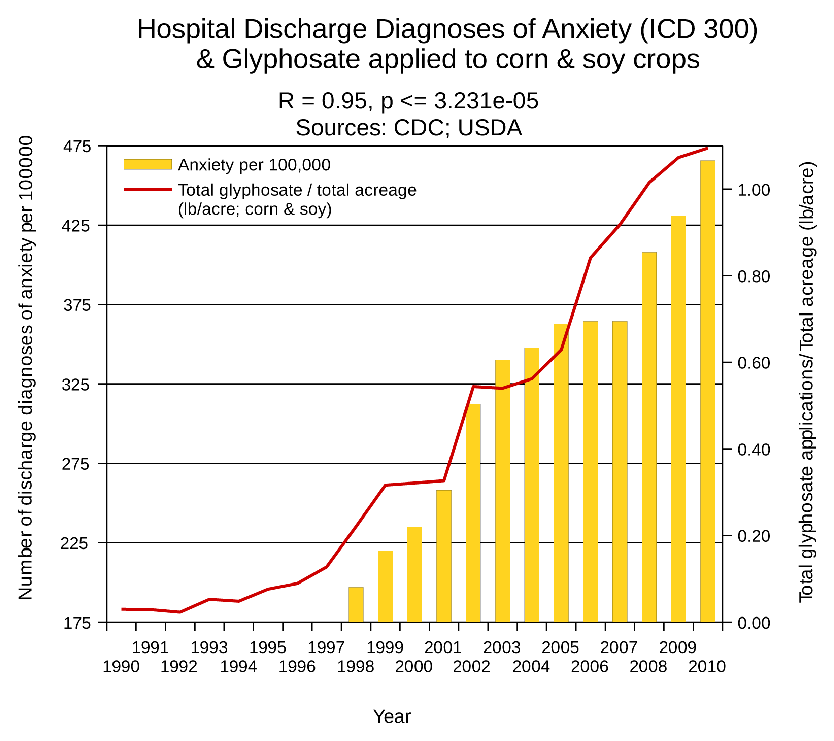
 [See citation 23]
[See citation 23]
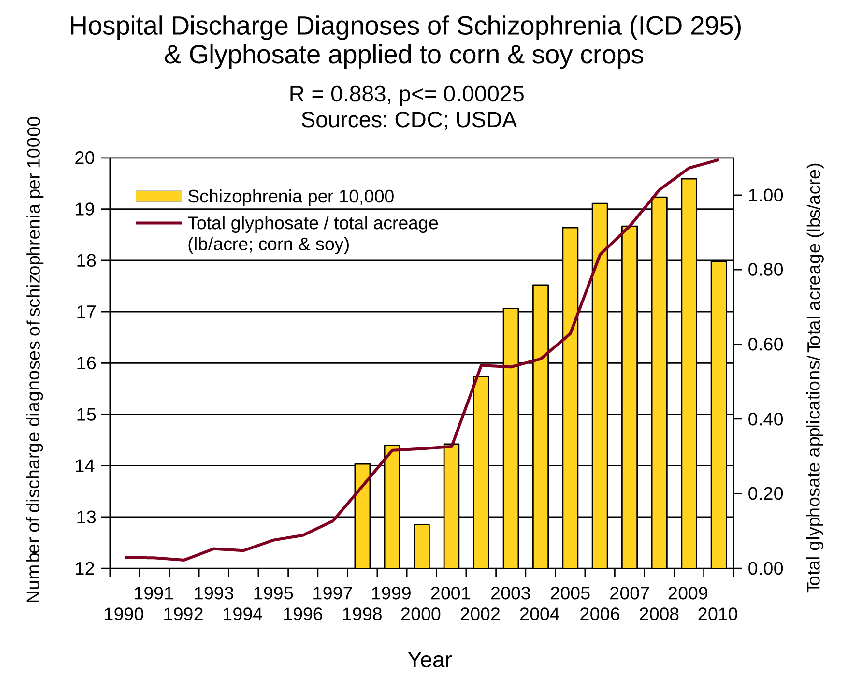
 [See citation 24]
[See citation 24]

 [See citation 26]
[See citation 26]
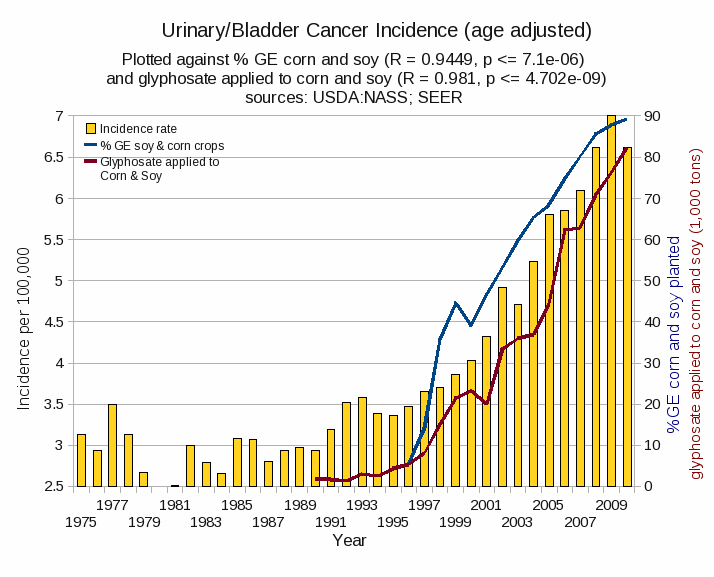
 [See citation 27]
[See citation 27]
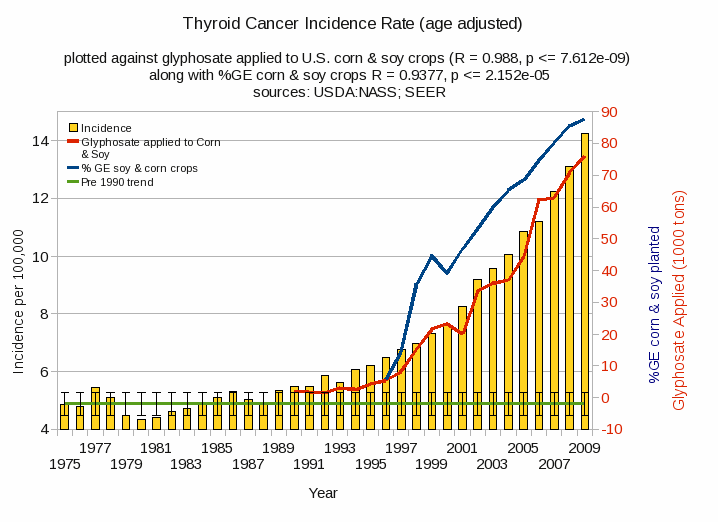
 [See citation 28]
[See citation 28]
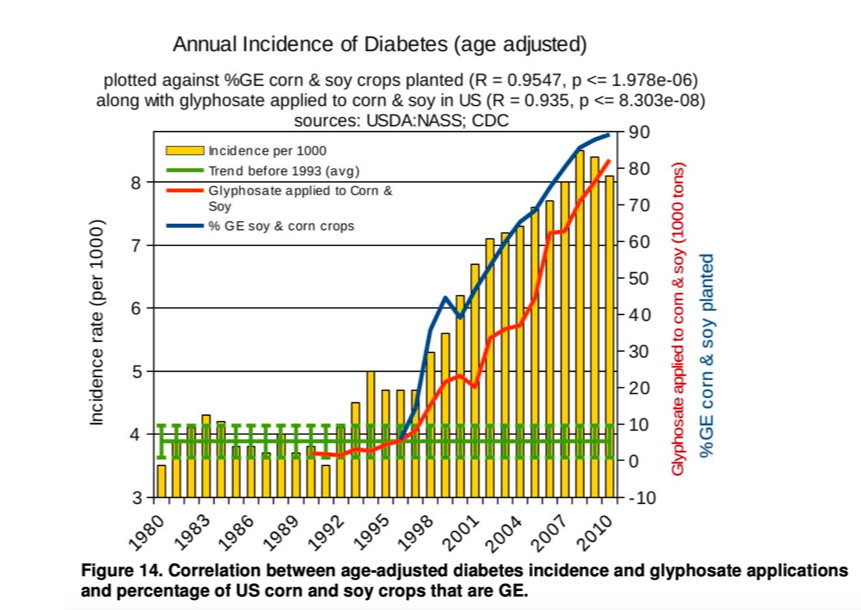
 [See citation 29]
[See citation 29]

 [See citation 30]
[See citation 30]
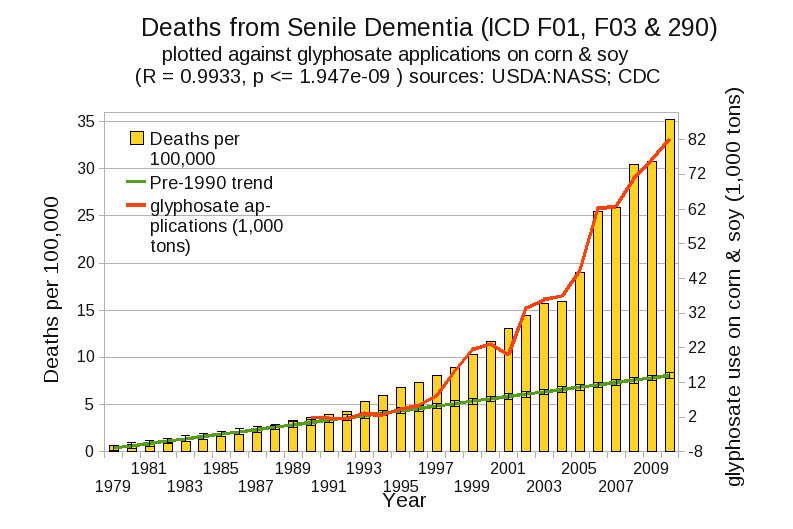
 [See citation 31]
[See citation 31]

 [See citation 32]
[See citation 32]
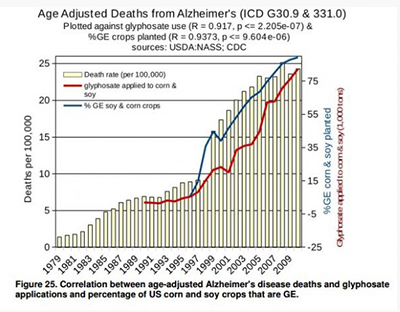
 [See citation 33]
[See citation 33]
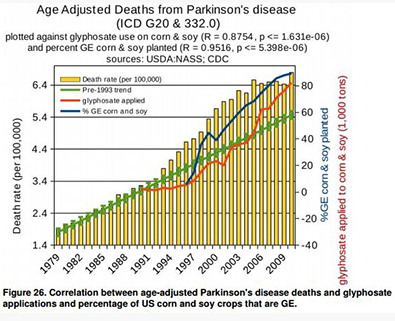
 [See citation 33]
[See citation 33]
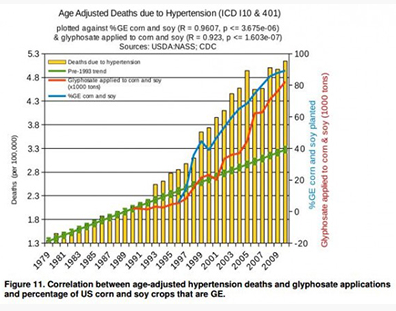
 [See citation 33]
[See citation 33]
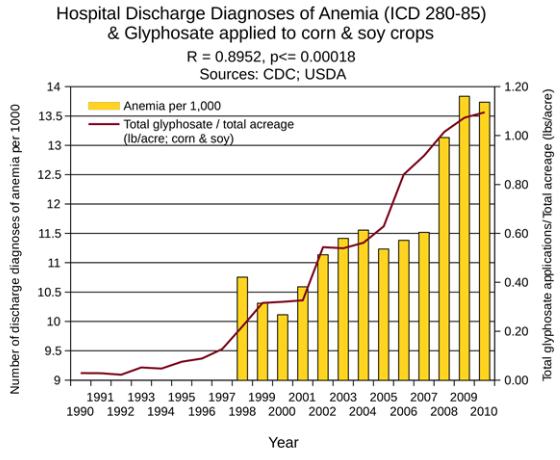
 [See citation 34]
[See citation 34]
Ways In Which Humans Can Help Reduce Negative Effects of Genetic Modification on the Environment (and what it does)
Three of the many ways in which humans can help reduce the negative effects of genetic modification on the environment are by buying organic, looking for "non-GMO" labels, and avoiding at-risk ingredients. There are five at-risk ingredients which are also known as the "Big Five". The first of the "Big Five" is corn: corn flour, meal, oil, starch, gluten, syrup, and sweeteners such as fructose, dextrose, and glucose; Modified corn starch. The second at-risk ingredient is beet sugar: sugar not specified as 100% cane sugar is likely from GE sugar beets. The third at-risk ingredient is soy: soy flour, lecithin, protein, isolate, and isoflavone, Vegetable oil, and vegetable protein. The fourth at-risk ingredient is canola: Canola oil (also called rapeseed oil). The last of the "Big Five" is cotton: Cottonseed oil.[39]
Data
(Data is also in research portion)

[See citation 7]

The potential avoided greenhouse gas emissions resulting from the yield increases of genetically modified crops (in the European Union). Graph (A) estimates per hectare and year and Graph (B) estimates for total European Union crop area per year.
COCs: carbon opportunity costs of land use.
PEMs: production emissions.
[See citation 16]

 [See citation 18]
[See citation 18]

 [See citation 19]
[See citation 19]

[See citation 20]

 [See citation 21]
[See citation 21]

 [See citation 22]
[See citation 22]

 [See citation 23]
[See citation 23]

 [See citation 24]
[See citation 24]

 [See citation 26]
[See citation 26]

 [See citation 27]
[See citation 27]

 [See citation 28]
[See citation 28]

 [See citation 29]
[See citation 29]

 [See citation 30]
[See citation 30]

 [See citation 31]
[See citation 31]

 [See citation 32]
[See citation 32]

 [See citation 33]
[See citation 33]

 [See citation 33]
[See citation 33]

 [See citation 33]
[See citation 33]

 [See citation 34]
[See citation 34]
Conclusion
Conclusion
Genetic modification is the alteration of an organism's (living thing) genotype using recombinant DNA technology to modify an organism's DNA and to achieve its desirable traits. There are two types of genetic modification/genetic engineering in plants: cisgenesis and transgenesis. There are many merits and demerits of genetic modification in plants. One merit is that disease and drought-resistant plants require fewer environmental resources (ie. water, fertilizer, etc.) and one demerit is an increase in herbicide use. There are also pros and cons of genetic modification in animals. For example, they are better able to resist disease but they have a higher susceptibility to stress. In microorganisms, a positive effect is that there are medicinal benefits to the growing population. However, there is a possibility of creating new or worse viruses. Genetic modification in humans also has benefits and drawbacks. For example, in the future genetic modification may be able to prevent, treat, or cure inherited disorders like beta thalassemia. A drawback is that there is a risk of an unwanted immune system reaction. There are numerous long-term effects of genetic modification like cancerous tumor growth, climate change mitigation, schizophrenia, insomnia, etc. Some ways in which humans can help reduce the negative effects of genetic modification on the environment are by buying organic, looking for "non-GMO" labels and avoiding at-risk ingredients.
What Next?
There is conflicting information regarding whether genetically modified foods are safe to consume. I can take my research further by investigating how genetic modification causes long-term effects in humans. I can also take it further by researching if the various medical conditions occur only because of genetic modification. People would be interested in knowing this because then they understand if genetically modified foods are safe to consume and at what quantity. Future research can also be used as a guide for people to know if they should be buying organic or GM foods (genetically modified foods). It can also be used for people who want to know if GM foods are harmful to them.
Citations
[1] “Genetic Modification.” WUR, www.wur.nl/en/dossiers/file/genetic-modification-1.htm. Accessed 2 Jan. 2024.
[2] Schouten, Henk J, et al. “CISGENIC Plants Are Similar to Traditionally Bred Plants: International Regulations for Genetically Modified Organisms Should Be Altered to Exempt Cisgenesis.” EMBO Reports, U.S. National Library of Medicine, Aug. 2006, www.ncbi.nlm.nih.gov/pmc/articles/PMC1525145/#:~:text=Cisgenesis%20is%20a%20particularly%20efficient,make%2Dup%20of%20the%20plant. Accessed 3 Jan. 2024.
[3] “Transgenic Organisms.” Genetics Generation, 16 Aug. 2023, knowgenetics.org/transgenic-organisms/#:~:text=Transgenic%20organisms%20have%20also%20been,%E2%82%AC%20(genetically%20modified%20organisms). Accessed 3 Jan. 2024.
[4] “Genetically Engineered Foods: Medlineplus Medical Encyclopedia.” MedlinePlus, U.S. National Library of Medicine, medlineplus.gov/ency/article/002432.htm#:~:text=Disease%2D%20and%20drought%2Dresistant%20plants,Faster%20growing%20plants%20and%20animals. Accessed 3 Jan. 2024.
[5] Ministerie van Economische Zaken, Landbouw en Innovatie. “Consequences of Gmos for Biodiversity.” Biotechnology | Government.Nl, Ministerie van Algemene Zaken, 30 July 2018, www.government.nl/topics/biotechnology/consequences-of-gmos-for-biodiversity#:~:text=Genetic%20modification%20produces%20genetically%20modified,by%20more%20dominant%20new%20species. Accessed 4 Jan. 2024.
[6] “Environmental Impacts.” CBAN, cban.ca/gmos/issues/environmental-impacts/#:~:text=Biodiversity%20Loss%3A%20The%20use%20of,monarch%20butterfly%20in%20North%20America. Accessed 5 Jan. 2024.
[7] May 2015 Are GM Crops Better for the Environment? - Gmoinquiry.Ca, gmoinquiry.ca/wp-content/uploads/2015/05/gm-and-environment-pamphlet-En.pdf. Accessed 5 Jan. 2024.
[8] B. Perzigian, Andrew. “Brief Summary of Genetic Engineering and Animals | Animal Legal & Historical Center.” Www.animallaw.info, 2003, www.animallaw.info/article/brief-summary-genetic-engineering-and-animals#:~:text=Pros%20of%20Genetic%20Engineering. Accessed 6 Jan. 2024.
[9] “Genetically Engineered Animals: Frequently Asked Questions.” BIO, archive.bio.org/articles/genetically-engineered-animals-frequently-asked-questions. Accessed 6 Jan. 2024.
[10] Bartee, Lisa, et al. “Genetic Engineering.” Principles of Biology, Open Oregon Educational Resources, openoregon.pressbooks.pub/mhccmajorsbio/chapter/genetic-engineering/#:~:text=Genetic%20engineering%20is%20the%20alteration,common%20method%20of%20genetic%20engineering. Accessed 6 Jan. 2024.
[11] Ormandy, Elisabeth H, et al. “Genetic Engineering of Animals: Ethical Issues, Including Welfare Concerns.” The Canadian Veterinary Journal = La Revue Veterinaire Canadienne, U.S. National Library of Medicine, May 2011, www.ncbi.nlm.nih.gov/pmc/articles/PMC3078015/.
[12] “Lameness - Definition, Meaning & Synonyms.” Vocabulary.Com, www.vocabulary.com/dictionary/lameness#:~:text=A%20state%20of%20being%20unable,unable%20to%20walk%20without%20limping. Accessed 13 Jan. 2024.
[13] “Genetically Modified Organisms (GMOs): Transgenic Crops and Recombinant DNA Technology.” Nature News, Nature Publishing Group, www.nature.com/scitable/topicpage/genetically-modified-organisms-gmos-transgenic-crops-and-732/#:~:text=Some%20benefits%20of%20genetic%20engineering,to%20the%20world’s%20growing%20population. Accessed 13 Jan. 2024.
[14] “GMO and Non-GMO: Pros and Cons.” ProTerra Foundation, 27 Jan. 2021, www.proterrafoundation.org/news/gmo-and-non-gmo-pros-and-cons/.
[15] “Pros and Cons of GMO Foods: Health and Environment.” Medical News Today, MediLexicon International, www.medicalnewstoday.com/articles/324576. Accessed 14 Jan. 2024.
[16] Genetically Modified Crops Support Climate Change Mitigation - Cell Press, www.cell.com/trends/plant-science/fulltext/S1360-1385(22)00004-8. Accessed 14 Jan. 2024.
[17] “GMO Side Effects with Jeffrey Smith.” YouTube, YouTube, 12 Jan. 2017, www.youtube.com/watch?v=uwX2xTf9i-I.
[18] Graph of US Rates of Autism Prevalence in First Grade Served under Idea ..., www.researchgate.net/figure/Graph-of-US-rates-of-autism-prevalence-in-first-grade-served-under-IDEA-compared-with_fig15_271724900. Accessed 15 Jan. 2024.
[19] Correlation between Inflammatory Bowel Disease and Glyphosate ..., www.researchgate.net/figure/Correlation-between-inflammatory-bowel-disease-and-glyphosate-applications-to-US-corn-and_fig20_283462716. Accessed 15 Jan. 2024.
[20] Correlation between Age-Adjusted Intestinal Infection Deaths And ..., www.researchgate.net/figure/Correlation-between-age-adjusted-intestinal-infection-deaths-and-glyphosate-applications_fig3_283462716. Accessed 15 Jan. 2024.
[21] Gunatilake, Sarath, et al. “Glyphosate’s Synergistic Toxicity in Combination with Other Factors as a Cause of Chronic Kidney Disease of Unknown Origin.” MDPI, Multidisciplinary Digital Publishing Institute, 31 July 2019, www.mdpi.com/1660-4601/16/15/2734. Accessed 15 Jan. 2024.
[22] Correlation between ADHD Prevalence and Glyphosate Applications to Corn and Soy Crops, www.researchgate.net/figure/Correlation-between-ADHD-prevalence-and-glyphosate-applications-to-corn-and-soy-crops_fig7_271724900. Accessed 15 Jan. 2024.
[23] Correlation between Anxiety Prevalence and Glyphosate Applications To ..., www.researchgate.net/figure/Correlation-between-anxiety-prevalence-and-glyphosate-applications-to-corn-and-soy-crops_fig8_271724900. Accessed 15 Jan. 2024.
[24] Correlation between Schizophrenia Prevalence and Glyphosate ..., www.researchgate.net/figure/Correlation-between-schizophrenia-prevalence-and-glyphosate-applications-to-corn-and-soy_fig9_271724900. Accessed 15 Jan. 2024.
[25] Correlation between Age-Adjusted Liver Cancer Incidence ... - Researchgate, www.researchgate.net/figure/Correlation-between-age-adjusted-liver-cancer-incidence-and-glyphosate-applications-and_fig14_283462716. Accessed 15 Jan. 2024.
[26] Correlation between Age-Adjusted Kidney Cancer Incidence ... - Researchgate, www.researchgate.net/figure/Correlation-between-age-adjusted-kidney-cancer-incidence-and-glyphosate-applications-and_fig15_283462716. Accessed 15 Jan. 2024.
[27] Correlation between Age-Adjusted Bladder/Urinary Tract Cancer And ..., www.researchgate.net/figure/Correlation-between-age-adjusted-bladder-urinary-tract-cancer-and-glyphosate-applications_fig9_283462716. Accessed 26 Jan. 2024.
[28] Correlation between Age-Adjusted Thyroid Cancer Incidence And..., www.researchgate.net/figure/Correlation-between-age-adjusted-thyroid-cancer-incidence-and-glyphosate-applications-and_fig8_283462716. Accessed 11 Feb. 2024.
[29] Leu, Andre. “The Science-Based Evidence to Ban Glyphosate and Gmos.” Regeneration International, Andre Leu https://regenerationinternational.org/wp-content/uploads/2018/10/RI-Logo-New.png, 19 Feb. 2023, regenerationinternational.org/2023/02/19/the-science-based-evidence-to-ban-glyphosate-and-gmos/. Accessed 11 Feb. 2024.
[30] María et al.. Journal of Organic Systems Applications and ... - Squarespace, static1.squarespace.com/static/5b57957f75f9ee124c3cb4f8/t/5b67a690575d1f9e8ace67d0/1533519506307/disease_glyphosate_and_gmos_pamphlet.pdf. Accessed 11 Feb. 2024.
[31] Correlation between Age-Adjusted Dementia Deaths and Glyphosate ..., www.researchgate.net/figure/Correlation-between-age-adjusted-dementia-deaths-and-glyphosate-applications_fig1_283462716. Accessed 11 Feb. 2024.
[32] Correlation between Age-Adjusted Obesity Deaths and Glyphosate ..., www.researchgate.net/figure/Correlation-between-age-adjusted-obesity-deaths-and-glyphosate-applications_fig7_283462716. Accessed 11 Feb. 2024.
[33] Zeese &, Kevin, et al. “Dramatic Correlation Shown between GMOS and 22 Diseases.” Truthout, Truthout, 19 Nov. 2014, truthout.org/articles/dramatic-correlation-shown-between-gmos-and-22-diseases/. Accessed 11 Feb. 2024.
[34] Seneff, Stephanie, et al. “Aluminum and Glyphosate Can Synergistically Induce Pineal Gland Pathology Connection to Gut Dysbiosis and Neurological Disease.” SCIRP, Scientific Research Publishing, 8 Jan. 2015, www.scirp.org/journal/paperinformation?paperid=53106. Accessed 11 Feb. 2024.
[35] Gostimskaya, Irina. “CRISPR-Cas9: A History of Its Discovery and Ethical Considerations of Its Use in Genome Editing.” Biochemistry. Biokhimiia, U.S. National Library of Medicine, Aug. 2022, www.ncbi.nlm.nih.gov/pmc/articles/PMC9377665/#:~:text=Currently%2C%20CRISPR%E2%80%93Cas9%20and%20related,babies%20carrying%20the%20introduced%20modifications. Accessed 11 Feb. 2024.
[36] “Benefits and Risks.” National Heart Lung and Blood Institute, U.S. Department of Health and Human Services, www.nhlbi.nih.gov/health/genetic-therapies/benefits-risks#:~:text=In%20the%20future%2C%20genetic%20therapies,cancers%20or%20infections%2C%20including%20HIV. Accessed 11 Feb. 2024.
[37] “Benefits and Risks.” National Heart Lung and Blood Institute, U.S. Department of Health and Human Services, www.nhlbi.nih.gov/health/genetic-therapies/benefits-risks#:~:text=Potential%20risks%20could%20include%20certain,use%20in%20the%20United%20States. Accessed 11 Feb. 2024.
[38] “Gene Therapy.” Mayo Clinic, Mayo Foundation for Medical Education and Research, 29 Dec. 2017, www.mayoclinic.org/tests-procedures/gene-therapy/about/pac-20384619. Accessed 11 Feb. 2024.
[39] “Shoppers Guide to Avoiding GE Food: | Tips for Avoiding Gmos.” Center for Food Safety, www.centerforfoodsafety.org/issues/311/ge-foods/shoppers-guide-to-avoiding-ge-food/1846/tips-for-avoiding-gmos. Accessed 11 Feb. 2024.
[40] Onlyorganic. “5 Ways Going Organic Can Affect Climate Change.” Only Organic, www.onlyorganic.org/5-ways-going-organic-can-affect-climate-change/. Accessed 11 Feb. 2024.
[41] “Better for the Planet.” Soil Association, www.soilassociation.org/take-action/organic-living/why-organic/better-for-the-planet/. Accessed 11 Feb. 2024.
[42] Meats, McLean. “Why Buying Organic Is Healthier.” McLean Meats - Clean Deli Meat & Healthy Meals, 27 Apr. 2023, mcleanmeats.com/why-buying-organic-is-healthier/. Accessed 11 Feb. 2024.
[43] Boast, Genevieve. “Is Eating Organic Really Better for You?: Equinox Kombucha.” Equinox Kombucha UK, 26 Sept. 2022, equinoxkombucha.com/blog/is-eating-organic-better-for-you/. Accessed 11 Feb. 2024.
[44] Hange, Ajinkya. “Five Ways You Can Save the Earth by Buying Organic.” Two Brothers Organic Farms, Two Brothers Organic Farms, 21 May 2021, twobrothersindiashop.com/en-us/blogs/informative/five-ways-you-can-save-the-earth-by-buying-organic. Accessed 11 Feb. 2024.
[45] Mike, and Mike. “The Environmental and Health Benefits of Organic Food.” Maverik Oils, maverikoils.com/the-environmental-and-health-benefits-of-organic-food/. Accessed 11 Feb. 2024.
[46] Ketterling, Alexa. “8 Reasons Why Consumers Choose to Buy Organic.” Centra Foods, www.centrafoods.com/blog/8-reasons-why-consumers-choose-to-buy-organic. Accessed 11 Feb. 2024.
[47] Top 10 Reasons To Go Organic, Renee Loux, 11 Nov. 2011, https://www.prevention.com/food-nutrition/healthy-eating/a20453119/top-reasons-to-choose-organic-foods/. Accessed 11 Feb. 2024.
[48] Forager Project. “Choosing Organic - Better for You and the Planet: Forager Project Blog.” Forager Project, 20 July 2023, www.foragerproject.com/blog/choosing-organic-better-for-you-and-the-planet/. Accessed 11 Feb. 2024.
[49] Marketing. “21 Reasons to Choose Organic.” Canada Organic Trade Association, 4 May 2022, choosecanadaorganic.ca/21-reasons-to-choose-organic/. Accessed 11 Feb. 2024.
[50] Meats, McLean. “5 Compelling Reasons to Buy Organic.” McLean Meats - Clean Deli Meat & Healthy Meals, 27 Apr. 2023, mcleanmeats.com/5-compelling-reasons-to-buy-organic/. Accessed 11 Feb. 2024.
[51] “Why Non-GMO Ingredients.” All Y’alls Foods, allyallsfoods.com/pages/why-non-gmo-ingredients. Accessed 11 Feb. 2024.
[52] Farm Fresh Meals. “How Organic Food Helps the Environment.” Farm Fresh Meals, www.farmfreshmeals.com/blogs/farm-fresh-blog/how-organic-food-helps-environment. Accessed 11 Feb. 2024.
[53] “Why Organic?” CCOF, www.ccof.org/page/why-organic. Accessed 11 Feb. 2024.
[54] “Genetically Modified Micro-Organisms for Industrial Food Enzyme Production: An Overview.” Foods (Basel, Switzerland), 11 Mar. 2020, www.ncbi.nlm.nih.gov/pmc/articles/PMC7143438/. Accessed 9 Mar. 2024.
[55] “Risks of Genetic Engineering.” Risks of Genetic Engineering | Down to Earth Organic and Natural, www.downtoearth.org/label-gmos/risks-genetic-engineering. Accessed 9 Mar. 2024.
[56] “Non-Gmo Corn.” Resilient Seeds, www.resilientseeds.com/non-gmo-corn.html. Accessed 9 Mar. 2024.
[57] “GMO Maize Safer than Non-GMO Alternative, Scientists Conclude.” Alliance for Science, 15 Sept. 2020, allianceforscience.org/blog/2018/02/gmo-maize-safer-than-non-gmo-alternative-scientists-conclude/. Accessed 10 Mar. 2024.
[58] Canada, Health. “Government of Canada.” Canada.Ca, / Gouvernement du Canada, 28 Aug. 2020, www.canada.ca/en/health-canada/services/consumer-product-safety/reports-publications/pesticides-pest-management/fact-sheets-other-resources/glyphosate.html. Accessed 10 Mar. 2024.
[59] “Toxic Effects of Glyphosate on the Nervous System: A Systematic Review.” International Journal of Molecular Sciences, 21 Apr. 2022, www.ncbi.nlm.nih.gov/pmc/articles/PMC9101768/. Accessed 10 Mar. 2024.
[60] Author links open overlay panelS. Jhansi Rani, and AbstractThe alteration of crops to improve their production was performed through the basis of selection before the creation of transgenics. This selection has been going on for thousands of years. By the year 2050. “Transgenic Plants: Types, Benefits, Public Concerns and Future.” Journal of Pharmacy Research, No longer published by Elsevier, 27 Aug. 2013, www.sciencedirect.com/science/article/pii/S0974694313003289.
[61] Care, Family First Urgent. “Good and Bad Bacteria: Understanding the Difference.” Family First Urgent Care Conroe, 18 July 2023, www.familyfirsturgentcareconroe.com/good-and-bad-bacteria-understanding-the-difference/.
Acknowledgement
Credits to Researchgate, Multidisciplinary Digital Publishing Institute, Regeneration International, Truthout, and Scientific Research Publishing.
I would like to thank my family for supporting me and helping me with this project. I would also like to thank my science fair coordinator Ms. Ontko because without her I would not be doing this.

